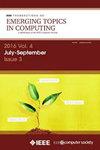多技术重定向行走方法的虚拟现实感知研究
IF 5.4
2区 计算机科学
Q1 COMPUTER SCIENCE, INFORMATION SYSTEMS
IEEE Transactions on Emerging Topics in Computing
Pub Date : 2024-10-09
DOI:10.1109/TETC.2024.3471249
引用次数: 0
摘要
在虚拟现实体验中,运动方法管理用户在虚拟环境中的运动。在虚拟现实中常见的自然运动在大型场景的视频游戏中可能会受到限制。因此,带有手柄或基于传送的移动方法的电子游戏变得越来越重要。重定向步行方法侧重于最大限度地利用实际工作空间。当用户在真实环境中移动时,会对虚拟环境中的移动进行细微的修改。虽然多技术重定向行走(MTRW)方法结合了四种增益算法的应用,结果很有希望,但需要用户的感知评估来确定其适用性。本文介绍了MTRW方法的存在和晕动因素的感知评价,并将其与完全自然行走(FNW)方法进行了比较。使用iggroup在场问卷(IPQ)测量在场因子,FNW和MTRW两种方法在总体在场得分上无显著差异。晕动症因子采用模拟晕动症问卷(SSQ)进行测量,这一次,两种运动方式在晕动症方面存在显著差异。晕机的潜在增加应该与最大限度地利用工作空间的好处进行权衡。本文章由计算机程序翻译,如有差异,请以英文原文为准。
A Virtual Reality Perceptual Study of Multi-Technique Redirected Walking Method
Within virtual reality experiences, locomotion methods manage the user’s movement within the virtual environment. The use of natural locomotion, common in virtual reality, can be limited in video games with large scenarios. Thus, video games with gamepad or teleport-based locomotion methods are gaining importance. Redirected walking methods focus on maximizing the exploitation of the real workspace. As the user moves in the real environment, subtle modifications are applied to that movement within the virtual environment. Although the results of the Multi-Technique Redirected Walking (MTRW) method that combines the application of four gain algorithms are promising, a perceptual evaluation with users is needed to determine its suitability. This article presents the perceptual evaluation of the presence and cybersickness factors for the MTRW method, comparing it with a Fully Natural Walking (FNW) method. The presence factor was measured with the Igroup Presence Questionnaire (IPQ), and no significant differences in the overall presence score were detected between the FNW and the MTRW methods. The cybersickness factor was measured using the Simulator Sickness Questionnaire (SSQ) and, this time, significant differences in cybersickness between the two locomotion methods were obtained. The potential increase in cybersickness should be weighed against the benefit of maximizing workspace utilization.
求助全文
通过发布文献求助,成功后即可免费获取论文全文。
去求助
来源期刊

IEEE Transactions on Emerging Topics in Computing
Computer Science-Computer Science (miscellaneous)
CiteScore
12.10
自引率
5.10%
发文量
113
期刊介绍:
IEEE Transactions on Emerging Topics in Computing publishes papers on emerging aspects of computer science, computing technology, and computing applications not currently covered by other IEEE Computer Society Transactions. Some examples of emerging topics in computing include: IT for Green, Synthetic and organic computing structures and systems, Advanced analytics, Social/occupational computing, Location-based/client computer systems, Morphic computer design, Electronic game systems, & Health-care IT.
 求助内容:
求助内容: 应助结果提醒方式:
应助结果提醒方式:


